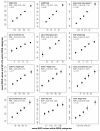Lifetime body size and reproductive factors: comparisons of data recorded prospectively with self reports in middle age
- PMID: 21241500
- PMCID: PMC3034712
- DOI: 10.1186/1471-2288-11-7
Lifetime body size and reproductive factors: comparisons of data recorded prospectively with self reports in middle age
Abstract
Background: Data on lifetime exposures are often self-reported in epidemiologic studies, sometimes many years after the relevant age. Validity of self-reported data is usually inferred from their agreement with measured values, but few studies directly quantify the likely effects of reporting errors in body size and reproductive history variables on estimates of disease-exposure associations.
Methods: The MRC National Survey of Health and Development (NSHD) and the Million Women Study (MWS) are UK population-based prospective cohorts. The NSHD recruited participants at birth in 1946 and has followed them at regular intervals since then, whereas the MWS recruited women in middle age. For 541 women who were participants in both studies, we used statistical measures of association and agreement to compare self-reported MWS data on body size throughout life and reproductive history, obtained in middle age, to NSHD data measured or reported close to the relevant ages. Likely attenuation of estimates of linear disease-exposure associations due to the combined effects of random and systematic errors was quantified using regression dilution ratios (RDRs).
Results: Data from the two studies were very strongly correlated for current height, weight and body mass index, and age at menopause (Pearson r = 0.91-0.95), strongly correlated for birth weight, parental heights, current waist and hip circumferences and waist-to-height ratio (r = 0.67-0.80), and moderately correlated for age at menarche and waist-to-hip ratio (r = 0.52-0.57). Self-reported categorical body size and clothes size data for various ages were moderately to strongly associated with anthropometry collected at the relevant times (Spearman correlations 0.51-0.79). Overall agreement between the studies was also good for most quantitative variables, although all exhibited both random and systematic reporting error. RDRs ranged from 0.66 to 0.86 for most variables (slight to moderate attenuation), except weight and body mass index (1.02 and 1.04, respectively; little or no attenuation), and age at menarche, birth weight and waist-to-hip ratio (0.44, 0.59 and 0.50, respectively; substantial attenuation).
Conclusions: This study provides some evidence that self-reported data on certain anthropometric and reproductive factors may be adequate for describing disease-exposure associations in large epidemiological studies, provided that the effects of reporting errors are quantified and the results are interpreted with caution.
Figures


References
-
- Rowland ML. Self-reported weight and height. Am J Clin Nutr. 1990;52(6):1125–1133. - PubMed
-
- Stevens J, Keil JE, Waid LR, Gazes PC. Accuracy of current, 4-year, and 28-year self-reported body weight in an elderly population. Am J Epidemiol. 1990;132(6):1156–1163. - PubMed
-
- Casey VA, Dwyer JT, Berkey CS, Coleman KA, Gardner J, Valadian I. Long-term memory of body weight and past weight satisfaction: a longitudinal follow-up study. Am J Clin Nutr. 1991;53(6):1493–1498. - PubMed
-
- Must A, Willett WC, Dietz WH. Remote recall of childhood height, weight, and body build by elderly subjects. Am J Epidemiol. 1993;138(1):56–64. - PubMed
Publication types
MeSH terms
Grants and funding
LinkOut - more resources
Full Text Sources

